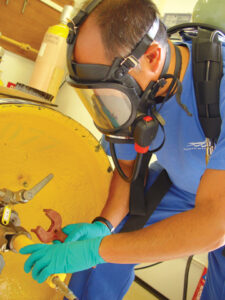

Becky Moran the Communications Officer for South West Water states that they will be spending £23,000 in 2011/12 to assess the condition of the sewerage network in the Radford area of Plymouth and identify the effects of saline infiltration.
When salt water enters the sewerage network it can cause unpleasant odours and damage mechanical equipment at sewage pumping stations and treatment works as well as taking up sewer capacity. Higher sea levels due to climate change could lead to more salt water entering the sewerage network.
Using data gathered during this assessment, South West Water will be investing in the region of a further £190,000 in 2012/13 to upgrade the sewerage network in Radford. This could include upgrading joints and valves affected by saline and lining or replacing damaged sewers.
Hopefully this will minimise the unpleasant odours that have associated with the treatment works.
We also suffer from the noise from the Radford Water Treatment Plant, The noise level appears to have been increasinsing over the last few years, and it keeps us awake at night. The noise is a continual pulsating machine noise/hum which is more apparant at night even with the windows closed.
There have also been numerous times in the small hours of the morning when heavy plant enters the site, resulting in flashing lights and audible reversing warning indicators beeping. I have passed on my complaint to SWW, waiting to hear back.
I do hope that the “improvements” to the Treatment works are not anything to do with the new Sherford Town which is coming along. Where is the sewage from all the planned new houses going to? I have never been able to find out what the arrangements might be but if it all comes to Radford, I don’t think it could cope.
I agree that not only is the smell a problem but the ‘noise pollution’ too is an issue. The constant ‘hum’ level (not the smell!) has increased significantly over the past few years.
Whilst SWW’s news of improvements at the Radford sewage works is positive, when they seek improvements to the design and management of the works any equipment purchased to reduce the smell must take in to account the noise levels produced by this equipment.
Coincidentally, we have just had a visit from SWW in Turnchapel. They have finally responded, after months/years of us complaining of the stink in the village. They have acknowledged to John Wheeler & Carron Pearse that they must take remedial action. As I understand the story, it has emerged that the sewerage from Mt Batten should have been routed to the top of the hill, but instead was routed through the village, causing an overload. They have promised a refund to one of the properties especially badly affected.
Very glad to hear this although the timescale and sums proposed seem less than ideal. I have complained about the noise from the works which has increased greatly; at night the noise travels particularly across the lake and affects my sleep if I open the window. SW Water were very polite, they said it was a temporaray generator (which they said they would turn off at night) and some worn valves. Presumably these are the valves being affected by saline. I think they need to look at noise as well as smell and I agree with the post regarding sewage discharge into the lake – they have built a lot of houses around the lake and the inevitable effect of this is that there will be increased recreational use of the water.
What is also needed at Radford Sewage Works (STW) and Marsh Mills STW etc, is UV light disinfection and sand filters to reduce the microbiological contaminates i.e. Pathogenic Human Faecal Coliform Bacteria and more harmful Human Viruses that are only diluted by 100 and 10 respectively by the Primary and Secondary existing STW systems. Viruses discharged from the STW outfall will also be reduced by natural UV sunlight and cooler sea water but in warmer summer waters with cloud cover can survive for several hours.
Raw sewage contains 3×10^7 Faecal Coliforms (30000000) per 100 millilitre and 1*10^5 viruses (100000) per 100 millilitre. The EU Bathing Water Directive Standards specify that 95% of samples must be less than 2000 Faecal Coliforms /100millilitre and zero viruses /100millilitre at defined bathing waters.
South West Water are permitted to discharge 4501 cubic metres/day of treated sewage into Hooe lake at a threshold referred to as DWF (Dry Weather Flow) (7 consecutive days of no rain). However in rain, the STW in/outflows will exceed DWF and temporary flows are permitted up to 3DWF during higher rain storm flows and even emergency flows when untreated raw sewage discharges are permitted.
The sewage works at Radford 30 years ago in it’s design phase was to have the outfall pipe discharging into the Cattewater but instead is now only a surface culvert next to the STW in Hooe lake where there is much less dilution from the smaller volume of water in Hooe Lake during spring/neap tides.
There is no Environment Agency mandatory testing in Hooe Lake for microbiological human intestinal Faecal Coliforms or Viruses. The only EA testing for these human sewage indicators is at the EU Designated Bathing Waters i.e. at East and West Hoe between April and September, with weekly sampling and lab testing.
”Hooe Lake, Cattewater & the Plym is not required or regulated to meet EU Designated Bathing Waters standards for Faecal Coliforms or human viruses as they are ‘not’ define bathing waters”
So Hooe Lake with it’s STW discharge is not the ideal place for healthy swimming or capsize from canoe or dinghy.